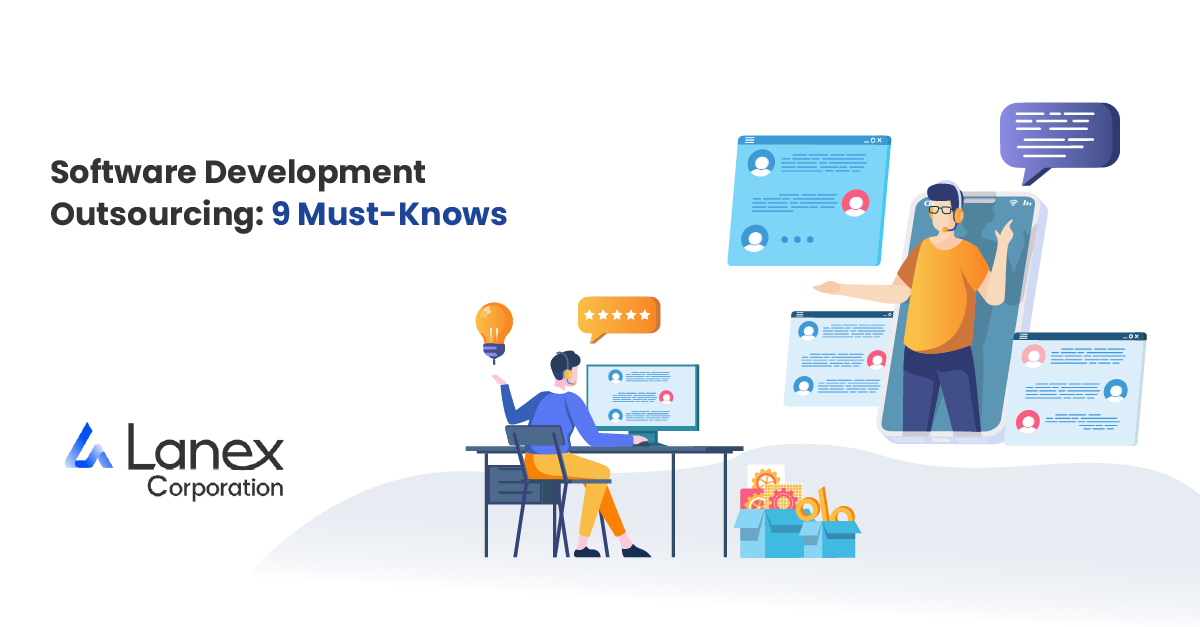
Software development outsourcing is expected, where a company brings in added resources to supplement its existing team. There are many benefits to this practice; however, there are also some risks and disadvantages that you should be aware of before engaging in this workforce solution. Below, we'll discuss some essential things to consider before deciding to bring on external resources.
Advantages of Software Development Outsourcing
This strategy provides various benefits, such as the flexibility to increase or decrease the number of workers based on the project's requirements, access to specialized skills and knowledge, and lower expenses associated with recruiting full-time staff members. Companies that utilize this must provide benefits and training. Businesses also use talent outsourcing to fill temporary or project-based positions, which can be advantageous for firms with shifting workloads.

Types of Software Development Outsourcing
Depending on your requirements, you may choose from various management solutions. Below are well-recognized types and their corresponding advantages:
- Onshore: This type involves hiring professionals based in the same country as the organization. It can benefit organizations that require frequent face-to-face interactions with staff members.
- Offshore: This type involves hiring professionals from different countries. It can be beneficial for organizations that are looking to reduce labor costs.
- Nearshore: This type involves hiring professionals in a nearby country. It can benefit organizations that want to take advantage of cultural similarities and time zone proximity.
- Hybrid: This type combines onshore, offshore, and nearshore workforce extension to create a balanced solution that meets the organization's specific needs.
Ultimately, the type of workforce solutions will depend on the organization's specific needs, budget, and other factors.
Risks and Disadvantages
While software development outsourcing may provide numerous benefits to firms, including the flexibility to scale up swiftly or down the number of people, access to specialized skills and knowledge, and lower costs associated with recruiting full-time personnel, there are risks and downsides to consider.
Some of the most significant risks and problems are a lack of control, communication and coordination problems, loyalty, higher costs, quality problems, and data security and privacy problems.
Development outsourcing may make it harder for firms to guarantee that external specialists follow their standards and expectations. Organizations may also need help communicating and coordinating with external workers, which might cause delays and errors. Contract staffing is transient. Therefore, external workers may need to be more committed to the business. Organizations may need effective management and monitoring to ensure external professional job quality. Lastly, organizations with outside professionals may have different security protocols, which could risk their data security and privacy.
Despite the risks and disadvantages associated with resource outsourcing, it can still be a valuable strategy for organizations looking to fill specific skills gaps or manage fluctuations in demand. When considering temporary staffing, it is crucial to carefully evaluate the criteria for choosing a provider.
Factors To Consider When Selecting Providers
It is crucial to consider several variables when choosing a resource outsourcing provider to establish a successful collaboration. Location is one thing to consider because the provider's location can affect how well they communicate and work with your team.
Working with a local supplier might reduce communication hurdles if your firm is in a different time zone. Another essential element is the provider's expertise and track record of delivering comparable tasks. Look for suppliers with industry expertise and a history of high-quality work.
Also, evaluate the provider's abilities and credentials. It is essential to have effective communication to ensure that the service provider understands the customer's expectations and delivers consistent updates on the project's status. The provider's work culture should match the client's to guarantee smooth integration. Cost matters, but it shouldn't be the primary concern. Check online reviews and the provider's industry status. Finally, if your project contains sensitive data, be sure the supplier has a solid security and compliance approach.
With all the essential factors to consider, it's time to start finding the right software development outsourcing provider for your business. Next, we will discuss the steps and strategies to finding the perfect provider that aligns with your needs and goals.
How To Find the Right Provider
Finding the right talent outsourcing provider for a business can be challenging, so here are some tips to ensure a successful collaboration.
First, determine your company's project demands. Consider the necessary staff, project length, and the particular talents or experience needed.
Once you have established your requirements, it's time to research project-based staffing companies. Find vendors with industry expertise and comparable project experience. Check online reviews and request client references. Check the suppliers' skills and certifications to ensure they can execute your job. To ensure the vendor understands your needs and provides frequent project updates, evaluate their communication and management abilities.
After choosing a provider, sign a contract that clearly describes the project's scope, the provider's duties, and the agreement's conditions to ensure that both sides understand their roles and can work together.
With these factors in mind, you can make an informed decision when selecting a provider. Now, let's explore some best practices for resource outsourcing.

Best Practices for Software Development Outsourcing
Setting clear goals and objectives for the project before starting the partnership is crucial. It ensures that the company and provider understand the project's needs and can collaborate. A practical resource outsourcing relationship also requires effective communication. The company should create open communication channels with the managed services provider and ensure that the provider is aware of the project's specifications and regularly informs the business of the project's status. Success also depends on giving the staff augmentation provider the required tools and training. This may involve offering project management tools, software, and other resources.
Defining duties and responsibilities for the contract staffing provider in the project will assist them in understanding their obligations and working well with the rest of the project team. Monitoring performance and offering feedback are also essential for success, as are controlling the provider's expectations and regularly analyzing and assessing the resource outsourcing relationship to identify any problems that need to be addressed and making modifications as required.
Following these best practices, organizations may guarantee their outsourcing relationship is productive, efficient, successful, and meets project objectives.
The Role of Technology in Software Development Outsourcing
Technology plays a vital role in software development outsourcing, as it helps facilitate communication, collaboration, and project management. One way technology is utilized through project management tools such as Asana, Jira, Trello, and Monday, which manage project tasks and progress, assign responsibilities, track time and expenses, and collaborate on documents and files. These tools help ensure that all project team members, including staff augmentation providers, know the project's goals and objectives and can work together effectively.
Providers can collaborate with the project team using communication tools such as Slack, Microsoft Teams, and Zoom. They can also function from anywhere thanks to virtual and remote work technologies such as VPN, Remote desktop, and Remote access.
An automated testing tool for software or a computerized data input tool for processing large amounts of data quickly and reliably can also help to speed up procedures and increase efficiency.
Software development outsourcing also requires security and compliance. Providers may utilize encryption, firewalls, and intrusion detection systems to protect sensitive data and comply with industry laws.
By utilizing these tools, businesses can ensure the success of their outsourced software development partnerships. Now, let's dive into the relationship between staff augmentation and project management.
Software Development Outsourcing and Project Management
To properly integrate human resource outsourcing into a project management process, various factors come into account. The project manager and outsourced software development provider must work together to meet project goals. It may require producing a thorough project plan outlining the project's scope, deliverables, and dates to integrate their work with the rest of the project team.
Goals alignment is also essential; the project manager should work with the development outsourcing provider to align their goals and objectives with the project's overall goals and objectives.
The project manager must monitor the staff augmentation provider's performance and offer comments to ensure they satisfy project criteria and may make improvements. Providers require resources, supervision, and project management software to integrate with the project team. A reporting mechanism is a must-have to report on their progress and difficulties so they can address them.

Legal and Compliance
software development outsourcing providers must be mindful of legal and regulatory requirements to safeguard the company and its employees. Outsourcing contractors have different legal obligations than employees do. Businesses should classify, tax, and keep records of people who work for themselves. Infractions of the law may result in hefty fines.
Companies in healthcare, finance, and technology must follow the rules too. Providers must understand the privacy requirements of HIPAA, GDPR, and CCPA and keep sensitive data safe. Data security and non-disclosure agreements are required.
Businesses should also ensure that their provider follows intellectual property laws and owns their work. Lastly, companies should know what software development outsourcing means for liability and insurance and ensure that the supplier has general and professional liability insurance to protect them from claims.
Conclusion
Successful collaborations need the careful selection of suppliers and legal and regulatory expertise. By following best practices, firms can boost efficiency, accomplish goals, and obtain specialized skills and knowledge.
LANEX is a dependable partner for software development outsourcing. Our highly-qualified and skilled team can assist you in achieving your project objectives. Your budget and schedule are taken into consideration when providing staff augmentation services. Discuss your workforce needs with us. Contact us now.




